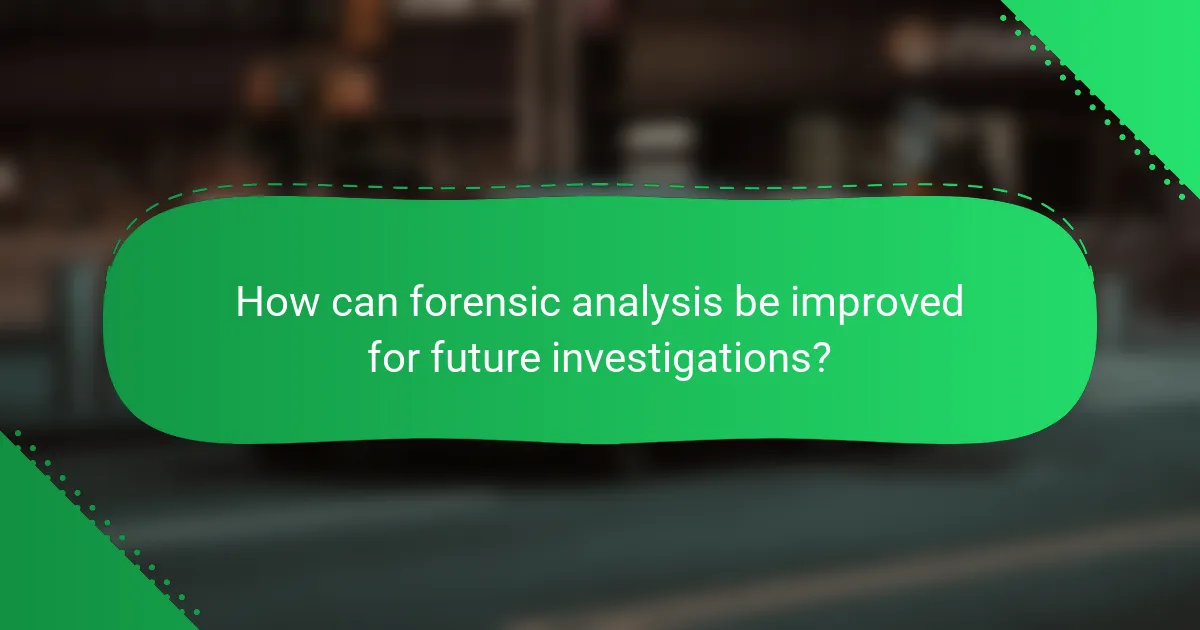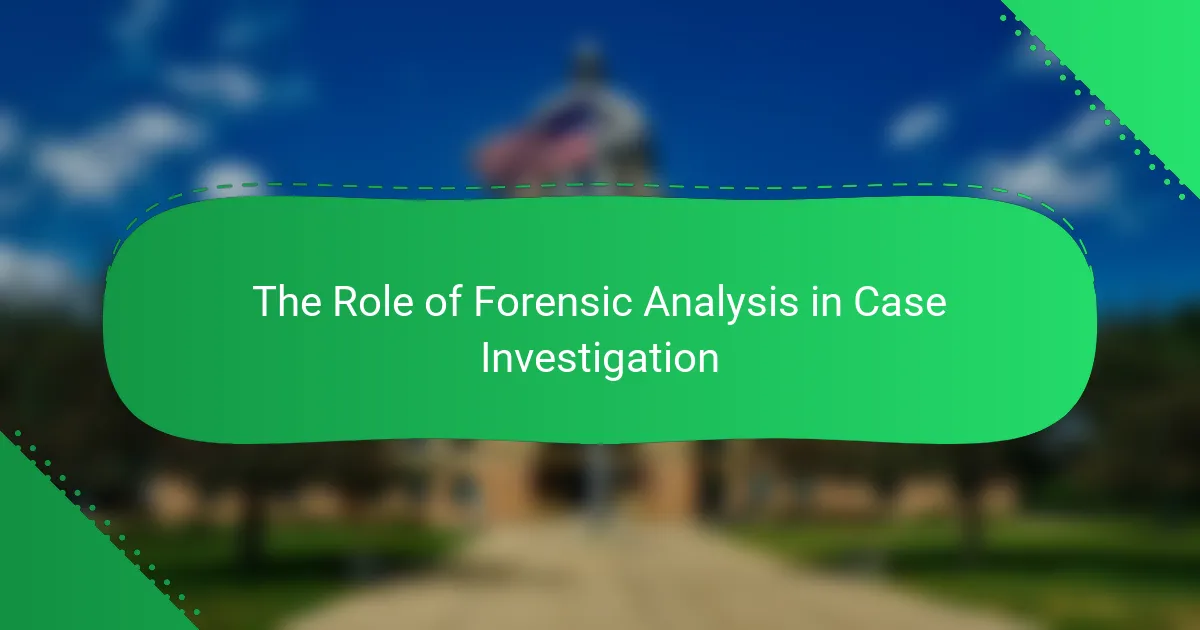Forensic analysis is a vital component of criminal investigations, involving the scientific examination of evidence such as fingerprints, DNA, and ballistic materials. This process establishes connections between suspects, victims, and crime scenes, providing critical insights into the circumstances of a crime. Key techniques in forensic analysis include DNA profiling, fingerprint analysis, and ballistics analysis, each contributing to a comprehensive understanding of evidence. The article also highlights advancements in forensic technology, training, and collaboration among forensic labs, which can enhance the effectiveness of investigations and improve outcomes in court proceedings.

What is the role of forensic analysis in case investigation?
Forensic analysis plays a critical role in case investigations. It involves the scientific examination of evidence to support criminal investigations. Forensic experts analyze physical evidence, such as fingerprints, DNA, and ballistic materials. This analysis helps establish connections between suspects, victims, and crime scenes. Forensic analysis can also provide insights into the timing and method of a crime. Data from forensic investigations can be pivotal in court proceedings. According to the National Institute of Justice, forensic evidence can significantly impact the outcome of trials. Thus, forensic analysis is essential for uncovering the truth in criminal cases.
How does forensic analysis contribute to solving crimes?
Forensic analysis contributes to solving crimes by providing scientific evidence that can link suspects to criminal activities. This analysis includes techniques such as DNA profiling, fingerprint analysis, and ballistics. DNA profiling can identify individuals with over 99% accuracy. Fingerprint analysis can match prints found at crime scenes to known individuals. Ballistics can determine the type of firearm used in a crime. These methods help law enforcement establish timelines and connections between victims and suspects. Studies show that cases with forensic evidence have higher conviction rates. Forensic analysis also aids in exonerating innocent individuals by providing clear evidence of their non-involvement.
What types of evidence can forensic analysis uncover?
Forensic analysis can uncover various types of evidence. This includes physical evidence such as fingerprints, hair, and fibers. It also encompasses biological evidence like blood, saliva, and other bodily fluids. Additionally, forensic analysis can reveal digital evidence from electronic devices. Trace evidence, such as gunshot residue or paint particles, can also be identified. Forensic analysis may uncover chemical evidence, including drugs or explosives. Each type of evidence plays a crucial role in investigations, helping to establish connections between suspects and crime scenes.
How does forensic analysis enhance the investigation process?
Forensic analysis enhances the investigation process by providing scientific evidence that supports criminal investigations. It utilizes various techniques such as DNA analysis, fingerprinting, and ballistics to gather crucial information. This evidence can link suspects to crime scenes or victims. It also helps in reconstructing events that occurred during a crime. Forensic analysis increases the accuracy of investigations by minimizing reliance on eyewitness testimony, which can be unreliable. The use of forensic evidence has been shown to improve conviction rates. Studies indicate that cases with forensic evidence are more likely to result in successful prosecutions. Overall, forensic analysis plays a vital role in strengthening the integrity of the investigation process.
Why is forensic analysis important in the criminal justice system?
Forensic analysis is crucial in the criminal justice system because it provides scientific evidence that can confirm or refute allegations. This type of analysis helps in identifying suspects through DNA, fingerprints, and other physical evidence. It also aids in reconstructing crime scenes, which can clarify the sequence of events. Forensic evidence is often pivotal in securing convictions or exonerating the innocent. Studies show that cases with forensic evidence have higher conviction rates. Additionally, forensic analysis enhances the overall integrity of the justice system by relying on objective data rather than subjective testimonies.
What impact does forensic analysis have on court proceedings?
Forensic analysis significantly impacts court proceedings by providing scientific evidence that can influence case outcomes. It helps establish facts related to a crime, such as identifying suspects or confirming alibis. Forensic evidence, including DNA, fingerprints, and ballistics, is often critical in linking a suspect to a crime scene. Courts rely on this evidence to make informed decisions regarding guilt or innocence. Studies show that cases with forensic evidence are more likely to lead to convictions. For example, according to the National Institute of Justice, DNA evidence has exonerated wrongfully convicted individuals, highlighting its importance in ensuring justice.
How does forensic analysis influence jury decisions?
Forensic analysis significantly influences jury decisions by providing scientific evidence that can validate or challenge testimonies. This type of analysis includes DNA, fingerprint, and ballistics evidence. Jurors often perceive forensic evidence as objective and reliable. Studies show that jurors are more likely to convict when presented with strong forensic evidence. For instance, a study published in the Journal of Forensic Sciences found that DNA evidence increased conviction rates by over 20%. The presence of forensic analysis can also lead jurors to question the credibility of witness accounts. Overall, forensic evidence plays a crucial role in shaping juror perceptions and decisions in criminal trials.

What are the main techniques used in forensic analysis?
The main techniques used in forensic analysis include DNA profiling, fingerprint analysis, and ballistics analysis. DNA profiling identifies individuals based on their unique genetic makeup. This technique is highly accurate and has been used in numerous criminal cases since its introduction in the 1980s. Fingerprint analysis examines the unique patterns on a person’s fingertips. It has been a standard practice in forensic science for over a century. Ballistics analysis studies firearms and ammunition to determine their origin and trajectory. This technique is crucial in cases involving gun-related crimes. Other techniques include toxicology, trace evidence analysis, and digital forensics. Each of these methods contributes to building a comprehensive understanding of evidence in criminal investigations.
How do different forensic techniques apply to various types of cases?
Different forensic techniques apply to various types of cases by providing specialized methods for evidence analysis. For instance, DNA profiling is crucial in violent crime cases for identifying suspects. Fingerprint analysis is commonly used in burglary cases to match prints left at crime scenes. Ballistics analysis helps in firearm-related cases by matching bullets to specific guns. Toxicology tests are essential in drug-related cases for detecting substances in a victim’s system. Digital forensics applies to cybercrime cases by recovering data from electronic devices. Each technique is tailored to address specific types of evidence and case requirements. These applications enhance the accuracy and reliability of investigations, leading to better outcomes in legal proceedings.
What is the significance of DNA analysis in forensic investigations?
DNA analysis is significant in forensic investigations as it provides a reliable method for identifying individuals. This technique analyzes genetic material found at crime scenes. It can link suspects to crimes through unique DNA profiles. DNA evidence is often more definitive than other forms of evidence. For instance, it has a high degree of accuracy in matching samples. Studies show that DNA evidence can lead to exonerations in wrongful convictions. In fact, the Innocence Project reports that DNA testing has overturned over 375 wrongful convictions in the United States. This highlights its critical role in ensuring justice.
How does fingerprint analysis aid in identifying suspects?
Fingerprint analysis aids in identifying suspects by matching unique patterns found in fingerprints. Each person’s fingerprints have distinct ridge patterns and minutiae points. Forensic experts collect fingerprints from crime scenes and compare them to databases. Automated Fingerprint Identification Systems (AFIS) store millions of fingerprints for quick searches. Studies show that fingerprint analysis has a high accuracy rate, often exceeding 99%. This method has been used in numerous criminal cases to confirm identities. For example, in the case of the 2004 Madrid train bombings, fingerprint analysis played a crucial role in identifying suspects. Thus, fingerprint analysis is a vital tool in forensic investigations.
What role does technology play in forensic analysis?
Technology plays a crucial role in forensic analysis by enhancing the accuracy and efficiency of investigations. It enables the collection, preservation, and examination of evidence in a systematic manner. Advanced tools like DNA sequencing and digital forensics software allow forensic experts to analyze biological samples and digital data effectively. For instance, DNA analysis can identify suspects with a high degree of certainty, often exceeding 99%. Additionally, technology facilitates the use of databases, such as the Combined DNA Index System (CODIS), which helps link cases and identify repeat offenders. The integration of technology in forensic analysis streamlines processes, reduces human error, and provides reliable results that are critical in legal proceedings.
How has digital forensics evolved in recent years?
Digital forensics has significantly evolved in recent years due to advancements in technology and methodology. The rise of cloud computing has introduced new challenges and opportunities for forensic investigators. Investigators now utilize advanced tools for data recovery and analysis. These tools can extract information from a variety of devices, including smartphones and IoT devices. Machine learning techniques have been integrated to enhance data analysis efficiency. This evolution allows for quicker identification of relevant evidence. Cybersecurity threats have also prompted the need for more robust forensic practices. As a result, training programs have adapted to include new technologies and trends.
What tools are essential for modern forensic analysis?
Essential tools for modern forensic analysis include digital forensics software, crime scene investigation kits, and DNA analysis equipment. Digital forensics software helps recover and analyze data from electronic devices. Crime scene investigation kits contain tools for evidence collection, such as gloves, bags, and swabs. DNA analysis equipment enables the extraction and examination of genetic material from samples. These tools are crucial for accurately gathering and analyzing evidence. Their use enhances the reliability of forensic investigations.

How can forensic analysis be improved for future investigations?
Forensic analysis can be improved for future investigations through enhanced technology and training. Implementing advanced techniques such as artificial intelligence can streamline evidence processing. Increased collaboration among forensic labs can lead to shared resources and knowledge. Regular training for forensic professionals ensures they stay updated on the latest methods. Standardizing protocols across jurisdictions can improve consistency in evidence handling. Investing in research can lead to innovative forensic techniques. Utilizing digital forensics can uncover crucial evidence from electronic devices. Improved communication between law enforcement and forensic experts can enhance case outcomes.
What best practices should forensic analysts follow?
Forensic analysts should follow strict protocols to ensure accuracy and reliability in their work. They must maintain a chain of custody for all evidence collected. This practice prevents contamination and preserves the integrity of the evidence. Analysts should document every step taken during the analysis process. Detailed records help in reproducing results and verifying findings. They must use validated methods and tools for analysis. Employing established techniques ensures that results are scientifically sound. Continuous training and education are essential for forensic analysts. Staying updated with advancements in technology and methodology enhances their skills. Collaboration with law enforcement and legal teams is crucial. Effective communication ensures that findings are understood and utilized correctly. Finally, analysts should adhere to ethical standards in their work. Upholding integrity fosters trust in forensic evidence used in investigations.
How can collaboration between forensic teams and law enforcement enhance outcomes?
Collaboration between forensic teams and law enforcement enhances outcomes by improving evidence collection and analysis. Effective communication allows for better understanding of case requirements. Forensic experts provide specialized knowledge that aids in interpreting complex evidence. Law enforcement can offer context that guides forensic investigations. Joint training fosters mutual respect and understanding of roles. This collaboration can lead to quicker case resolutions. Studies show that integrated approaches increase conviction rates. For example, a report by the National Institute of Justice indicates that collaborative efforts can reduce case backlogs significantly.
What training is necessary for forensic analysts to stay current?
Forensic analysts must engage in continuous education and specialized training to stay current. This includes attending workshops and seminars on the latest forensic techniques. Analysts should also pursue certifications from recognized organizations, such as the International Association for Identification. Regular participation in professional conferences helps analysts network and learn about recent advancements. Online courses and webinars can provide updated knowledge on emerging technologies and methodologies. Additionally, forensic analysts should review current literature and research in forensic science journals. Keeping abreast of changes in legal standards and regulations is also essential for effective practice.
What are common challenges faced in forensic analysis?
Common challenges faced in forensic analysis include evidence contamination, lack of standardization, and technological limitations. Evidence contamination can occur during collection or storage, compromising the integrity of samples. Lack of standardization in procedures leads to inconsistencies in results across different laboratories. Technological limitations may restrict the ability to analyze certain types of evidence effectively. Additionally, human error can impact the accuracy of forensic findings. These challenges can hinder the reliability of conclusions drawn from forensic analysis.
How can contamination of evidence be prevented?
Contamination of evidence can be prevented by following strict protocols during evidence collection and handling. Proper training of personnel is essential to ensure they understand contamination risks. Use of gloves and masks minimizes the transfer of biological material. Evidence should be collected in clean, sterile containers to avoid cross-contamination. Sealing evidence with tamper-proof packaging protects it from external influences. Maintaining a clear chain of custody ensures accountability and traceability of evidence. Environmental controls, such as temperature and humidity regulation, also help preserve evidence integrity. Adhering to these practices significantly reduces the risk of evidence contamination.
What steps can be taken to ensure the integrity of forensic findings?
To ensure the integrity of forensic findings, implement strict chain-of-custody procedures. This involves documenting every person who handles evidence. Secure storage of evidence is essential to prevent contamination. Utilize standardized protocols for evidence collection and analysis. Regular training for forensic personnel enhances adherence to best practices. Conduct independent peer reviews of forensic methods and results. Employ quality control measures to validate forensic techniques. Lastly, maintain transparency in reporting findings to uphold credibility.
What are practical tips for utilizing forensic analysis effectively?
Utilizing forensic analysis effectively requires a systematic approach. First, establish a clear objective for the analysis. This ensures that the focus remains on relevant evidence. Next, collect evidence meticulously to avoid contamination. Proper chain of custody must be maintained to validate findings. Employ appropriate forensic tools and techniques suited for the case type. Training and expertise in these methods are crucial for accurate results. Collaborate with multidisciplinary teams to enhance analysis perspectives. Regularly review and update forensic protocols to incorporate advancements in technology. These practices lead to more reliable and actionable forensic insights.
The primary entity of this article is forensic analysis, which plays a vital role in criminal investigations by examining evidence scientifically. The article outlines how forensic analysis provides critical insights through techniques such as DNA profiling, fingerprint analysis, and ballistics, linking suspects to crimes and enhancing the integrity of the justice system. It discusses the types of evidence uncovered, the impact on court proceedings, and the importance of technology in modern forensic practices. Additionally, it addresses best practices, common challenges, and the significance of collaboration between forensic teams and law enforcement to improve investigation outcomes.



